Foreign Exchange Receipts and Payments Data for the First Quarter of 2023 — Press Conference Transcript_Data Interpretation_State Administration of Foreign Exchange
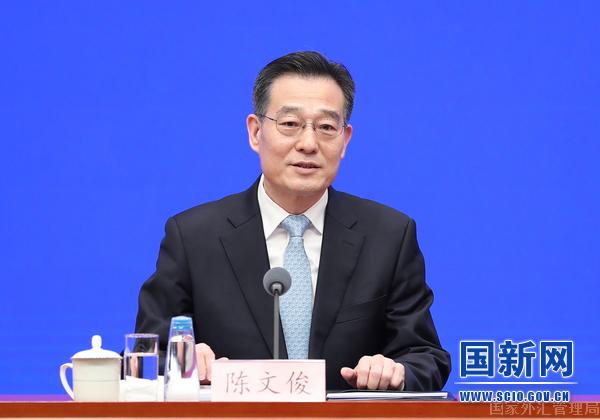
Foreign Exchange Receipts and Payments Data for the First Quarter of 2023 — Press Conference Transcript
The State Council Information Office (SCIO) held a press conference at 10:00 AM on Friday, April 21, 2023. Ms. Wang Chunying, Deputy Administrator and Press Spokesperson of the State Administration of Foreign Exchange (SAFE), was invited to unveil the data on foreign exchange receipts and payments for the first quarter of 2023 and answer media questions.

Chen Wenjun (Photo by Luan Haijun)
Chen Wenjun, Director General of the Press Bureau of the State Council Information Office (SCIO) and Spokesperson of the SCIO:
Ladies and gentlemen, good morning. We are pleased to welcome Ms. Wang Chunying, Deputy Administrator and Press Spokesperson of the SAFE. She will present the data on China’s foreign exchange receipts and payments for the first quarter of 2023, and answer your questions.
Now I will give the floor to Ms. Wang Chunying.
2023-04-21 10:00:27
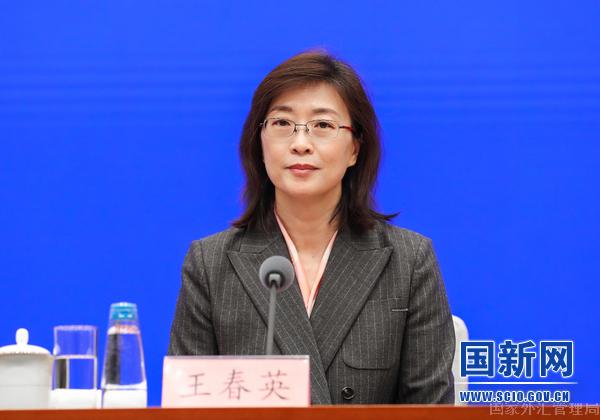
Wang Chunying (Photo by Xu Xiang)
Wang Chunying, Deputy Administrator and Press Spokesperson of the SAFE:
Good morning, everyone. Welcome to today’s press conference. Now, I would like to brief you on China’s foreign exchange receipts and payments situations for the first quarter of 2023 and then I will take your questions.
In the first quarter of 2023, there were still uncertainties in the international financial market, with an increasing downward pressure on the global economy and a slowdown in the tightening of monetary policy in major developed economies. Facing a complex external environment, China has followed the general principle of pursuing progress while ensuring stability, and has made concrete efforts to promote high-quality development under the guidance of the CPC Central Committee with Comrade Xi Jinping as the core. Major macroeconomic indicators have stabilized, and the economy has maintained a momentum of recovery and development. China’s foreign exchange market was generally stable, the renminbi exchange rate against the US dollar increased slightly, and the cross-border capital flow became more balanced.
According to the data on foreign exchange settlement and sales by banks in the first quarter of this year, in US dollar terms, banks settled USD 546 billion and sold USD 561.3 billion, representing a deficit of USD 15.3 billion; or in renminbi terms, banks settled RMB 3.74 trillion and sold RMB 3.84 trillion, recording a deficit of RMB 105.5 billion. For cross-border receipts and payments by non-banking sectors, in US dollar terms, banks registered USD 1.4850 trillion in foreign-related receipts and USD 1.4508 trillion in foreign-related payments for customers, representing a surplus of USD 34.2 billion; or in renminbi terms, banks handled foreign-related receipts of RMB 10.17 trillion and payments of RMB 9.93 trillion for customers, recording a surplus of RMB 232.9 billion.
China’s foreign exchange receipts and payments for the first quarter of 2023 show the following characteristics:
First, China’s cross-border capital flows are generally stable. In the first quarter of 2023, the cross-border receipts and payments by non-banking sectors recorded a surplus of USD 34.2 billion, while the foreign exchange settlement and sales by banks posted a deficit of USD 15.3 billion. Specifically, the surplus reached a seasonal high before the Spring Festival in terms of cross-border receipts and payments by non-banking sectors, but it tended to reach a basic equilibrium in February and March. The balance in foreign exchange settlement and sales by banks fluctuated in a narrow range in January and February and was represented by a small deficit in March. To sum up, the supply and demand of domestic foreign exchange were basically in balance.
Second, the cross-border capital flows under the current account were stable, while that under the capital account ran smoothly and orderly. In the first quarter of 2023, the net inflow of capital under trade in goods continued to be relatively high, while the net outflow of capital under trade in services increased year on year, which was mainly attributed to the fact that the resident travelling abroad has increased but was still lower than its pre-pandemic level. The net inflow of foreign direct investment (FDI) in China remained, and the foreign investment in China’s securities market showed a net increase. Meanwhile, China’s outward direct investment and its holdings of foreign securities maintained a reasonable and orderly development trend.
Third, the foreign exchange sales rate was kept at a stable level for nearly one year, while the foreign exchange financing by enterprises remained stable. In the first quarter of 2023, the sales rate, a measure of customers’ willingness to buy foreign exchange, which is the ratio of foreign exchange purchased by customers from banks to foreign-related foreign exchange payments made by customers, stood at 68%, basically the same as that in the fourth quarter of 2022. The sales rate for each quarter has remained at around 68% since the second quarter of 2022. In terms of financing, the outstanding domestic foreign exchange loans of market participants, such as Chinese enterprises, reached USD 281 billion by the end of February 2023, an increase of USD 9.7 billion from the end of 2022. By the end of March, the balance of foreign currency financing under international trade, such as import refinancing and forward letter of credit, stood at USD 73.1 billion, a slight decline of USD 3.7 billion from the end of 2022.
Fourth, the foreign exchange settlement ratio increased steadily, and the balance of enterprises’ foreign exchange deposits remained basically stable. In the first quarter of 2023, the foreign exchange settlement ratio, a measure of customers’ willingness to settle foreign exchange, or the ratio of foreign exchange sold by customers to banks to customers’ foreign-related foreign exchange receipts, reached 64%, up by 1 percentage point from the fourth quarter of 2022. By the end of February 2023, domestic foreign exchange deposits held by Chinese enterprises and other market participants totaled USD 640.6 billion, an increase of USD 6.5 billion from the end of 2022.
Fifth, the volume of China’s foreign exchange reserves remained basically stable. China’s foreign exchange reserves increased by USD 56.2 billion from the end of 2022 to USD 3.1839 trillion at the end of March this year, mainly due to the combined effects of currency translation, asset price changes, and other factors.
Looking ahead, under the guidance of Xi Jinping Thought on Socialism with Chinese Characteristics for a New Era, the SAFE will fully implement the guiding principles of the 20th CPC National Congress. We will work holistically to ensure both development and security, and continuously deepen the reform and opening up in the foreign exchange sector. More efforts will be made to advance the high-standard opening up under capital account steadily and orderly to facilitate cross-border trade, investment and financing, and to optimize the foreign exchange reserve operation and management system with Chinese characteristics. We will constantly improve the two-pronged “macro-prudential management and micro regulation” framework to guard against the risks and shocks from the external market, and maintain the stable operation of the foreign exchange market and national economic and financial security, to serve the high-quality development of the real economy.
The facts mentioned above are what I want to share with you on the main data of China’s foreign exchange receipts and payments for the first quarter of 2023. Now, I’d like to take your questions. Thank you.
2023-04-21 10:07:41
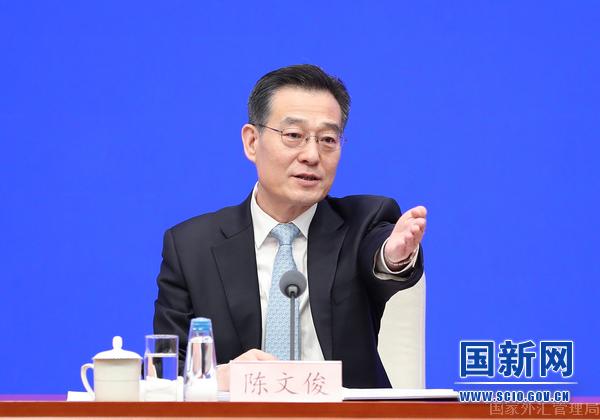
Chen Wenjun invites reporters to raise questions. (Photo by Luan Haijun)
Chen Wenjun:
So now I’ll open the floor for questions. Prior to posing your questions, kindly specify your news agency.
2023-04-21 10:08:03
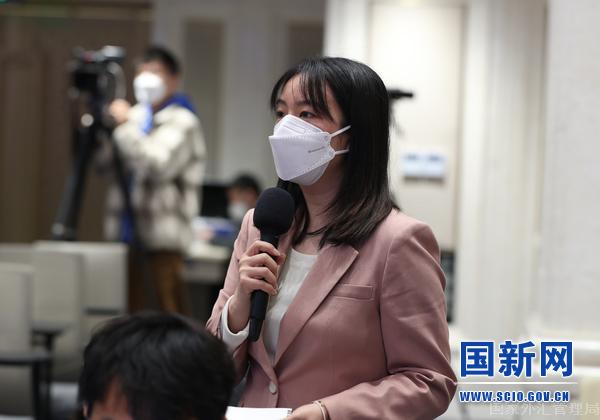
A reporter from CCTV raises a question. (Photo by Liu Jian)
CCTV:
Since the beginning of this year, there have been some changes in the domestic and international economic and financial environment. What will you say about the performance of the foreign exchange market in the first quarter of this year? What are the new changes and features? Thank you.
2023-04-21 10:24:59
Wang Chunying:
Overall, China’s foreign exchange market has achieved a good start in the first quarter of this year. It can be observed that the main features are more stable performance in the renminbi exchange rate, reasonable market expectations, and an autonomous balance of the supply and demand in the domestic foreign exchange market.
First, the renminbi exchange rate was generally stable from a global perspective, with a slight appreciation despite two-way fluctuations. As of yesterday, the onshore exchange rates of the renminbi rose by 1% against the US dollar from the end of 2022. In terms of multilateral exchange rate, the renminbi exchange rate index rose by 1.3% according to China Foreign Exchange Trade System, while the emerging market currency index (EMCI) increased by 1.1% during the same period. Turning to the market movement: the trend of the renminbi exchange rate has become more stable lately. Due to the effects of foreign economic and financial shocks, as well as seasonal factors, the renminbi exchange rate fluctuated in the market throughout the first two months of this year, particularly around the Spring Festival. Since the mid-March, the renminbi exchange rate has been steadily rising, as major economic indicators in China were improving, and the monetary tightening policy in major developed economies was narrowing in scope and slowing down in pace. As a result, the first finding we came to is that, from a global perspective, the renminbi’s exchange rate has seen two-way fluctuations within a reasonable range and a slight appreciation since the beginning of the year.
Second, the exchange rate expectation of the market participants was stable, and the way they made foreign exchange transactions became more reasonable. We noticed that the indicators such as foreign exchange forwards and options have shown no apparent signs of one-way appreciation or strong expectation of depreciation in the renminbi exchange rate. The market participants maintained a rational transaction behavior of “settling foreign exchange when the rate is high and buying foreign exchange when the rate is low”. In February, the renminbi depreciated because customers such as businesses and individuals exchanged foreign currency for renminbi, which was why the settlement ratio rose by nearly 9 percentage points this month from January. According to our analysis, customers had reasonable needs to sell foreign exchange when the renminbi depreciated. It is observed that with the appreciation of the renminbi in mid-to-late March, the willingness to buy foreign exchange was strong among business participants, and the foreign exchange settlement and sales by banks posted a deficit in March. Thus, in the first quarter, the exchange rate expectation of the market participants was stable, and their foreign exchange trading became more rational, showing an obvious sign of the rational trading mode mentioned above.
Third, the autonomous balance of the supply and demand in the domestic foreign exchange market was further consolidated. From the perspective of foreign exchange settlement and sales by banks, the foreign exchange market achieved an autonomous clearance in the first quarter of this year. As the foreign exchange market was supplied with foreign exchanges by banks reducing their holdings, overseas entities buying and selling of foreign exchanges in the interbank market, etc., it balanced the small deficit of foreign exchange settlement and sales by customers. From the point of view of BOP in recent years, China’s current account surplus, foreign investment, and other sources of funds have been mainly balanced by outward investments by domestic market participants, thereby enabling some sort of automatic matching of the sources with using of foreign funds. According to the preliminary data, in January and February, the current account surplus FDI in China was still the primary source of foreign exchange funds for China. Foreign funds were mainly used as the outward direct investments and investments in overseas securities. This also explains some of the discussions about where our surplus has gone. In recent years, the People’s Bank of China (PBC) has almost withdrawn its “regular” intervention in the foreign exchange market, so the source and using of foreign funds are mainly among market participants.
To sum up, the steady recovery of China’s economy from the beginning of this year has laid a consolidated foundation for a good start for the foreign exchange market. Meanwhile, the role of renminbi exchange rate as an automatic stabilizer for adjusting BOP has been obvious, and the market participants have become more mature and rational and can better adapt to changes in the external environment. All of these ensured the stable operation of the foreign exchange market.
This is my answer to your question, thank you.
2023-04-21 10:25:12
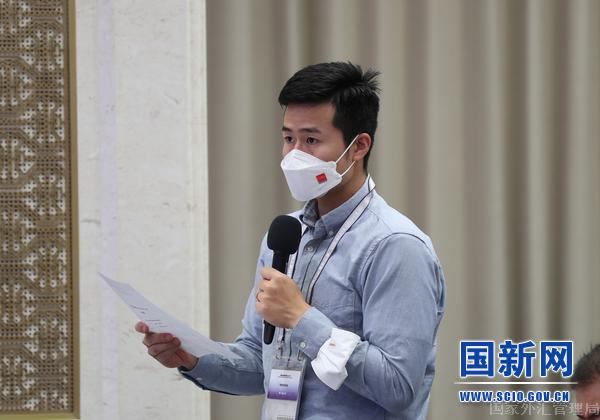
A reporter from China News Service raises a question. (Photo by Liu Jian)
China News Service:
What’s the situation about the inflow of FDI in recent years? What do you think about the prospect of FDI in China? Thanks.
2023-04-21 10:33:42
Wang Chunying:
Direct investment reflects medium- and long-term investment intentions, and investors are more interested in the long-term development prospects of a country’s economy and some of its fundamental advantages.
From a global perspective, China has always been a major destination for FDI. The COVID-19 pandemic has increased the volatility of the world economy and finance, which exerted huge impacts on the global FDI. In 2020, the outbreak of the pandemic constrained economic activity, so the global FDI plummeted. In 2021, the recovery of the world economy drove the rapid growth of FDI as it rebounded from a low position. In 2022, the global economic recovery slowed down, so did the growth of FDI, which gradually returned to its pre-pandemic level. The net FDI in BOP is calculated according to the unified international standard, which includes capital investment and earnings reinvestment. Many foreign-funded enterprises profit from their operations and may not remit all the money abroad. Many of them are optimistic about a country’s economy, so the profits stay within the country and are reinvested. There are also shareholder loans, which fall into the category of direct investment. Overall, China has excelled globally in absorbing FDI, and the net inflow of FDI in China in the past decade was among the world’s highest.
Speaking of prospects, what can foreign investors gain by investing in China? Foreign investors can share the investment, transformation, and market dividends of China’s high-quality economic development by investing in China.
First, China’s overall situation is stable, and the Chinese economy has maintained a medium-high growth in the past decade. The return on FDI in China is stable and at a relatively high level globally. Our calculations show that, over the previous five years, the return on FDI in China has been around 9.1%, while in Europe and the US around 3%. The return on FDI in emerging economies such as Brazil, South Africa, and India has been around 4% – 8%. It can be clearly seen that the return on FDI in China is among the highest.
Second, China has the world’s best manufacturing capability. Its infrastructure is well-developed, and its industrial and supply chain systems are complete and stable. At the same time, the quality of the Chinese labor force is relatively high, with 240 million people having received higher education. All these continue to provide a good foundation for the innovation and development of multinational companies. Additionally, the Chinese economy is on the course of transformation into high-quality development, with new growth points springing up, such as the development of science and technology innovation and the expansion of opening up in the service sector, which will continue to attract the inflow of FDI.
Third, China has a large population, with the largest middle-income population in the world and a huge potential domestic consumer market, which provides more opportunities for foreign investors in production, sales, and services in China. Surveys by some foreign chambers of commerce and global management consulting firms, we have seen lately, show that as China’s economy recovers, foreign investors are more confident in investing in China and more optimistic about its economic development prospects. We believe that foreign investors will continue to invest in the Chinese market steadily in the future.
On the policy front, China will adhere to a high-standard opening up, improve the business environment, and reduce foreign investment restrictions to better serve the foreign-invested enterprises. The SAFE will continue to facilitate cross-border investment and financing and help stabilize and expand the scale of FDI. Thanks.
2023-04-21 10:33:56
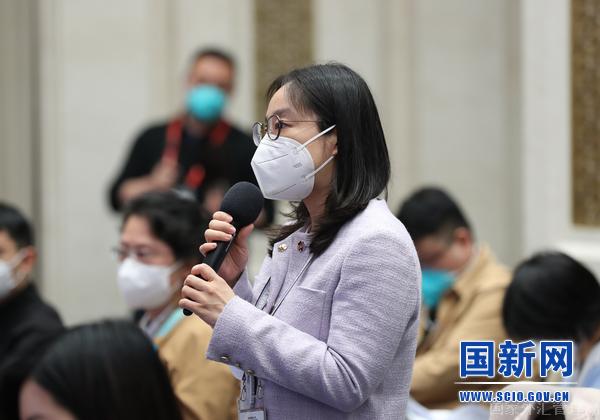
A reporter from the Economic Daily raises a question. (Photo by Liu Jian)
Economic Daily:
What is the current situation of foreign investors investing in renminbi assets? What changes do you see in the future? Thank you.
2023-04-21 10:40:23
Wang Chunying:
Thank you for your question. I am going to answer your question from the following aspects.
In recent years, the overall scale of foreign investment in renminbi assets has risen, and China has gradually become the leading force in absorbing portfolio investment among emerging economies. Last year, under high inflationary pressure, the Fed rapidly tightened monetary policy, and as a result, both the exchange rate and interest rates of the US dollar rose significantly. The scale of cross-border bond investments absorbed by countries worldwide decreased greatly, and the stock markets of major emerging economies saw a retraction of funds. Under such circumstances, China’s foreign exchange market and securities market remained stable, although China also faced the impact of Sino-US interest rate differentials on the renminbi exchange rate and investment adjustments of foreign funds in the Chinese securities market. The investments of foreign central banks and banking institutions in China’s bond market were relatively stable, and foreign capital in the China’s securities market showed a net inflow overall. The changes in the scale of cross-border capital inflows and outflows under securities investment did not change the overall equilibrium of BOP in China.
With the improvement of the internal and external environment in recent months, foreign investment in Chinese securities was on an upward trend. First, China’s economy has steadily recovered, and market expectations have been boosted. Foreign investors have become increasingly enthusiastic about investing in renminbi assets. Second, due to multiple factors, the exchange rate and interest rates of the US dollar have recently fallen from their high levels, and the spread inversion of 10-year treasury bonds between China and the US has tended to converge, having narrowed by half from a peak of 1.5 percentage points to the current level of about 0.7 percentage points. In January 2023, the net increase in China’s domestic shares held by foreign investors hit a record high; in March, the balance of China’s domestic bonds held by foreign investors rebounded from February.
In the future, foreign investors will continue to invest in China’s securities market, as they are attracted by several advantages of the renminbi assets: steady profitability, high investment value and strong appeal for investors seeking to diversify portfolio. I’ll touch on each of these briefly.
First, the renminbi’s value is stable, which keeps foreign investors from big exchange losses. The renminbi exchange rate has remained generally stable at an appropriate and balanced level in recent years. Even in 2022, when the external environment is complex and volatile, the fluctuation of the renminbi exchange rate was significantly lower than that of the Japanese yen, the British pound, the euro, and major emerging market currencies. Thus, foreign investors will not suffer significant exchange losses in holding renminbi assets.
Second, the renminbi-denominated assets have strong appeal for investors seeking to diversify portfolio. China’s economic cycle is not synchronized with that of major developed economies. The macroeconomic policy, the interest rate, exchange rate and asset prices in China are relatively independent, which endows renminbi assets with a better diversification effect in global asset allocation. People who make investments understand this point, and appreciate it. At the same time, China’s bond market is the second largest in the world in terms of size, which means we have good liquidity. With the characteristics of safety and liquidity, the renminbi assets have gradually become quasi-safe assets.
Third, the renminbi bond price is less volatile with stable returns. From a global perspective, volatility in renminbi bond returns is low. In most cases, the higher the volatility, the riskier the security, so it means that the investment return of renminbi bonds is more stable. According to the calculation, last year, the volatility of annualized monthly return of the renminbi treasury bond index was 2.4%, and that of the US bond was 6.6%. Through such a comparison, we can find out that the renminbi bond price is less volatile with stable returns.
Fourth, China’s securities market is undervalued and has good investment prospects. No matter the P/E ratio or P/B ratio or other indicators, the current valuation of A shares is relatively low, so the investment value is comparatively high, and the potential risk is relatively low.
Overall, China’s economy will progressively improve, its financial market will steadily open up, and there is still potential for foreign investment to enter the country. At present, foreign investors’ current holdings of both onshore stock and bond portfolios are at low levels, so there is ample room for them to invest in China’s securities market.
This is my response to your question. Thank you.
2023-04-21 10:40:35

A reporter from ThePaper.cn raises a question. (Photo by Liu Jian)
ThePaper.cn:
Recently, some developed economies kept on raising interest rates. Have there been any changes to China’s external debt, and how does the SAFE evaluate China’s current external debt level? Thanks.
2023-04-21 10:51:57
Wang Chunying:
We can observe and evaluate changes in China’s external debt from macro and micro perspectives.
At the micro level, market participants were more rational and cross-border financing adjustment was moderate. In recent years, market participants have been able to view the changes in interest rates and foreign exchange rates in a more rational way, and their expectations have become more stable. In line with the actual needs of trade and investment, we utilized and adjusted domestic and foreign financing reasonably, and thus observed more smooth changes in the external debt. Fed’s adoption of quantitative easing (QE) has lowered the financing costs in US dollars from 2020 to 2021. Therefore, the external financing demand of market participants expanded moderately, and the outstanding external debt of traditional financing types, such as cross-border deposits, loans, and trade credit, grew at an average annual rate of 8%, which was significantly lower than the 21% annual growth rate during the last round of Fed’s QE from 2009 to 2013. In 2022, the Fed began to tighten monetary policy. The balance of financing external debt fell by 10%, which was markedly lower than the 34% decline in 2015. In the first quarter of this year, the outstanding financing external debt further stabilized. These changes show that if there is no excessive leveraging in the early stage, there will not be substantial deleveraging in the later stage, which is my explanation of the rise and fall of the external debt scale from the perspective of micro perspective.
From a macro perspective, the total amount of China’s external debt is reasonable, with its structure being constantly optimized and risks controllable. First, the scale of external debt is compatible with China’s economic development. It is a relatively desirable and benign pattern of external debt development for a country if it can fully absorb external funds to support its domestic economic development within a moderate range. In recent years, China’s external debt has generally grown steadily, and the ratio of outstanding external debt to GDP has always remained within the range of 14%-16%. Second, the structure of China’s external debt has been constantly optimized. At the end of last year, the proportion of the outstanding external debt in domestic currency and the outstanding medium- and long-term external debt reached 45%, up by 7 percentage points and 11 percentage points respectively from the end of 2016. About 30% of China’s external debt is the domestic renminbi bond held by overseas investors, of which most are medium- and long-term investments. Therefore, the overall risk of external debt servicing is relatively low. Third, the main external debt indicators are within the safety line, and the synergy between external assets and liabilities is enhanced. As of the end of last year, the ratio of external debt to GDP, ratio of external debt to exports, debt service ratio, and ratio of short-term external debt to foreign exchange reserves of China were all within the international safety line and far lower than the overall level of developed countries and emerging markets. At the same time, according to the statement of BOP, China presents itself as a country with net foreign assets. At present, the overseas assets held by foreign exchange market participants, excluding foreign exchange reserves, are close to USD 6 trillion, of which USD 3.5 trillion is in securities, deposits, loans, and other assets with good liquidity. Under the regulation of market mechanism, external assets and liabilities can be reallocated among different market participants, which provides sufficient financial support for them to undertake external debt repayment obligations.
According to our observation from micro and macro perspectives, we believe that the scale of China’s external debt is reasonable, and it is expected to maintain a stable development trend in the future. SAFE will continue to improve cross-border investment and financing facilitation in the upcoming phase and work holistically to meet market participants’ needs for cross-border financing while maintaining stable development and security. Meanwhile, we will also continue to keep a close eye on the security of external debt. Thanks.
2023-04-21 10:52:23
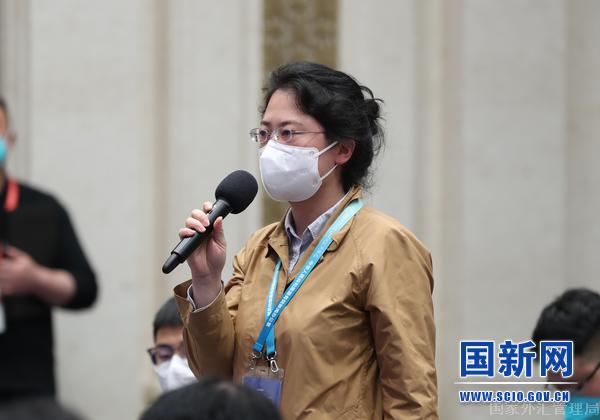
A reporter from Bauhinia Magazine raises a question. (Photo by Liu Jian)
Bauhinia Magazine:
According to the data just released, China’s foreign exchange market has started well this year. In your opinion, will this good start last? What would you say about the future trend of China’s foreign exchange market? Thank you.
2023-04-21 10:53:40
Wang Chunying:
My answer to your question is yes, and China’s foreign exchange market’s strong start will continue. According to the economic trend at home and abroad and the characteristics of China’s foreign exchange market, it has a better foundation to maintain stable operations under the dual support of sound macroeconomic fundamentals and its inherent resilience.
On the one hand, major economic indicators are improving, further consolidating the internal foundation for the smooth operation of the foreign exchange market. With the stabilizing and recovering of China’s economy, the GDP in the first quarter increased by 4.5% year on year, which shows the resilience, potential and vitality of the Chinese economy. The market expectation has also improved significantly. The IMF estimates that China’s GDP will grow 5.2% this year, 2.2 percentage points higher than that of last year. Besides, many world-renowned investment banks have also raised their expectations for China’s economic growth, and most of them estimate that China’s GDP growth will exceed 6%. While on the contrary, the major developed economies are facing increasing downward pressure. The global economy is forecast to grow 2.8% in 2023, down 0.6 percentage points from that of last year. A series of data shows an obvious gap between domestic and foreign economic growth, and the foundation for the stable operation of the foreign exchange market is very good. At the same time, China will unswervingly deepen reform and expand high-standard opening up to the outside world. The SAFE will continue implementing policies to stabilize foreign trade and investment. These will further enhance the smooth operation and healthy development of the foreign exchange market. Since the beginning of this year, with the slowing down of the Fed’s tightening monetary policy, the market generally expects that the Fed’s interest rate hike may end. Because the dollar may lose momentum for sustained appreciation and given the interest rate gap between China and the US has been closing, there will likely be less of an external influence on China’s foreign exchange market.
On the other hand, the resilience of China’s foreign exchange market has been enhanced, enabling it to better adapt to changes in the external environment. More elasticity has been seen in the renminbi. The market participants have developed a better understanding of the two-way fluctuation of the exchange rate, so their expectation on the exchange rate has become more stable. Besides, the role of the renminbi exchange rate as an “automatic stabilizer” of macroeconomic adjustments and international payments has been increased. The renminbi has been more widely used in cross-border transactions, and its share in cross-border payments was close to 50% in 2022 and increased further in the first quarter of this year, which helps reduce the risk of currency mismatch in cross-border transactions. With the promotion of foreign exchange risk neutrality, more enterprises came to understand how to manage risks in foreign exchange through various publicity and learning and became more adapted to exchange rate fluctuations.
The fact that China’s foreign exchange market has been more mature and the market participants have become more rational is an internal positive factor for the stability of the foreign exchange market. Therefore, China’s foreign exchange market is better positioned for stability. At the same time, there are still unstable and uncertain factors in the external environment, so we will continue to strengthen statistical monitoring and deepen analyzing various influencing factors. Besides, the SAFE will continue to sum up the experience of preventing and dealing with external risks and improve macro-prudential management and micro regulation to safeguard the stability of China’s foreign exchange market and national economic and financial security. Thanks.
2023-04-21 10:53:53
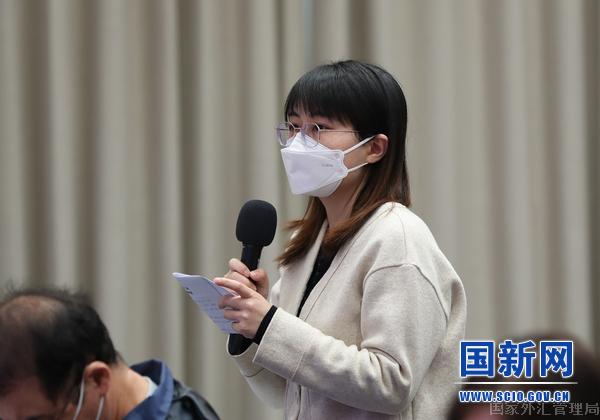
A reporter from 21st Century Business Herald raises a question. (Photo by Liu Jian)
21st Century Business Herald:
Just now, you mentioned that SAFE has been promoting risk neutrality awareness in Chinese enterprises. What other measures will SAFE take this year to guide Chinese enterprises, particularly micro, small and medium-sized enterprises (MSMEs), to avoid exchange rate risks? Thanks.
2023-04-21 11:11:21
Wang Chunying:
Before answering this question, I once again ask you to continue to help us carry out publicity. In recent years, we have intensified our efforts to raise the awareness of risk neutrality of Chinese enterprises and have achieved remarkable results. We will continue to proceed with the work this year. SAFE always encourages enterprises to adopt appropriate strategies to manage exchange rate risk exposure according to their actual situation. There are many ways for enterprises to control exchange rate risks. In addition to hedging through derivatives, the use of renminbi settlement is also a good way. And trade financing, whether it is a late payment or early payment, late collection or early collection, is also a great method to hedge risks. According to the survey of SAFE, in the first quarter of this year, a considerable number of enterprises have adopted methods, including renminbi settlement, hedging operations, adjusting settlement methods, and changing the speed of reimbursement of goods to manage the exchange rate risk. These are all excellent methods.
Efforts will be made to promote enterprises to establish a sense of risk neutrality, especially among MSMEs, and to make them do better in exchange rate hedging. To this end, we will work in the following aspects and strive to enhance enterprises’ ability to improve the quality and efficiency in risk management of foreign exchange.
First, we will continue to offer guidance on raising their awareness of exchange rate risk neutrality. For example, we will expand the coverage of publicity in this aspect. Especially, we will offer targeted guidance to those enterprises with potential demands that have not carried out or rarely used hedging operations. Besides, we will provide more detailed and targeted exchange rate risk management guidelines. We plan to work with the State-owned Assets Supervision and Administration Commission (SASAC) to compile cases of hedging guidelines for state-owned enterprises and prepare a set of cases of enterprise exchange rate risk management. We count on media friends to help us publicize.
Second, we will support financial institutions to enhance service capacity building. We will improve the special assessment of exchange rate risk management of financial institutions on serving enterprises and guide and encourage banks to optimize the credit margin system, especially for MSMEs. At the same time, we will enhance the business capacity of bank branches to provide better services to more market participants, particularly MSMEs. Doing so will form a long-term mechanism for banks to serve the enterprises in the area of exchange rate risk management. We will continue to make steady and concrete efforts in this regard.
Third, we will provide more support for MSMEs in exchange rate hedging. We continue to pool efforts to optimize the cost-sharing mechanism among the government, banks, and enterprises so as to reduce the hedging costs of MSMEs. At the same time, we need to ensure that the existing policies continue to be effective. Government departments have taken numerous actions over the last two years to lower the hedging expenses for MSMEs. At the same time, we encourage the development of new forms of trade and support the integrated foreign trade service platform in providing foreign exchange hedging services for MSMEs.
Finally, I would like to stress again that enterprises must establish awareness of exchange rate risk neutrality. We encourage enterprises to base themselves on the main business, adhere to financial stability and sustainable development, and keep exchange rate risk exposure within a controllable range. Besides, they should prudently arrange the currency structure and maturity of assets and liabilities and choose appropriate exchange rate hedging strategies. Thanks.
2023-04-21 11:11:46
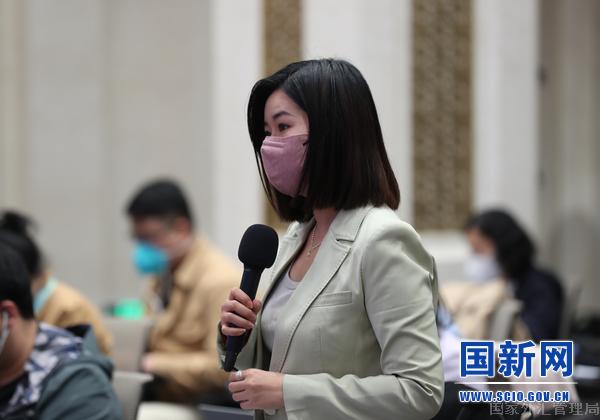
A reporter from Yicai raises a question. (Photo by Liu Jian)
Yicai.com:
This year, the external situation is still severe and complicated, and our foreign trade faces challenges. What has the SAFE done to stabilize foreign trade recently? What new measures will be taken? Thank you.
2023-04-21 11:12:28
Wang Chunying:
In terms of stabilizing foreign trade, SAFE has further advanced the reform and opening up in the foreign exchange sector and promoted foreign trade growth with high-quality facilitation policies. What we have done is as follows: First, we expanded the scope and improved the quality of policies to facilitate foreign exchange receipt and payment in trade for high-quality enterprises. Last year, with broadened service scope, these policies benefited more SMEs nationwide. By the end of March this year, an amount of USD 1.4 trillion has been granted to facilitate foreign exchange receipt and payment in trade for high-quality enterprises. Next, we will continue to improve the coverage, quality, and efficacy of these facilitation policies and encourage banks’ enthusiasm, initiative, and creativity in implementing such policies, so that more enterprises operating with integrity can enjoy policy convenience. We will strive to foster a market environment where “the more honest the enterprise is, the more convenient the procedure will be” and “the more compliant the bank is, the more independent the audit will be”.
Second, we step up the high-level opening up for cross-border trade and investment. We encourage more high-tech companies and specialized and sophisticated enterprises to borrow external debts independently within a certain quota and expand their financing channels. By the end of last year, enterprises in 17 provinces or municipalities directly under the central government had borrowed external debts under the facilitation quota, with an average interest rate of 2.4%. It has significantly reduced the financing cost of enterprises, which is conducive to business operations and trade. At the same time, SAFE implemented the pilot program of external debt registration in which the pilot enterprises are not required to register each specific case in the utilization of external debts. It effectively facilitates market participants’ use of external debts and decreases their “foot-cost”. Optimizing the integrated cash-pooling of both domestic and foreign currencies for multinational companies, we have greatly saved their costs, improved the efficiency of bank-enterprise business handling, and promoted the facilitation of investment and financing. In the future, we will continue to push ahead with pilot projects on a higher level of opening up in foreign trade and investment and instruct the implementation of policy measures in the four free trade zones (FTZs) in China, such as the Lin-gang Special Area of China (Shanghai) Pilot Free Trade Zone. We will evaluate and improve relevant pilot policies promptly, and constantly optimize such policies through pilot projects. We aim to promote the facilitation policies further so that more businesses can enjoy the convenience.
Third, we will urge enterprises to improve their exchange rate risk management capacity. More efforts will be made to promote the awareness of exchange rate risk neutrality among enterprises and to reduce the hedging costs for MSMEs.
Fourth, we will expand the application scenarios of cross-border financial service platforms. At present, seven financing scenarios and three foreign exchange facilitation scenarios have been successfully launched at the cross-border financial service platform, which has more than 500 participating banks and serves more than 80,000 participants, with a total financing amount of USD 250 billion, and facilitating foreign exchange payments of over USD 880 billion. The cross-border financial service platform is very useful. We have publicized it in detail in the past, and you can learn more about it. In the future, we will continue to expand the application scenarios at the platform, and facilitate cross-border trade, investment, and financing of SMEs to ensure the steady and sound development of the foreign-related economy. The more enterprises and banks use the platform, the more SMEs will enjoy the benefits of policies to facilitate foreign trade, investment, and financing.
In terms of stabilizing foreign trade, what the SAFE has done and will do is to promote foreign trade growth through high-quality facilitation policies. Thanks.
2023-04-21 11:13:03
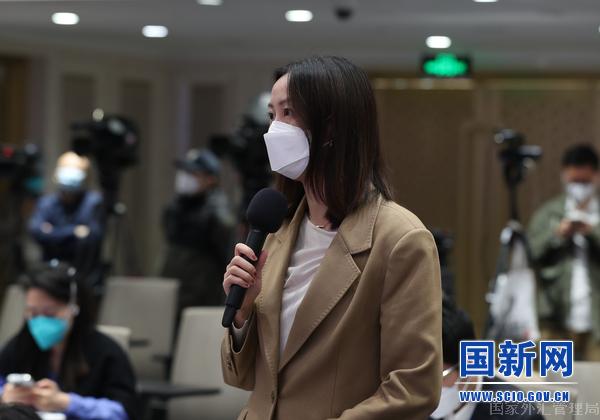
A reporter from Phoenix TV raises a question. (Photo by Liu Jian)
Phoenix TV:
The current account surplus for 2022 was high, creating favorable conditions for stabilizing the foreign exchange market. The growth of the global economy is expected to decline this year. What’s your opinion on the performance of the current account this year? Thanks.
2023-04-21 11:26:29
Wang Chunying:
Your observation is correct. In recent years, China’s current account has shown strong stability, and the current account surplus has continued to grow steadily, which has played a positive role in stabilizing the BOP and the foreign exchange market. This year, people are concerned about the impact of changes in external demand and the resumption of cross-border flows of people. I will give my response and analysis from these two aspects. Overall, China’s trade in goods and services has been more effective and efficient in recent years, which has helped the country maintain a reasonable current account surplus and given the foreign exchange market considerable support.
The trade surplus in goods will remain relatively high, as structural changes have gradually taken place in foreign trade in recent years, which have provided more support to exports. First, new drivers of trade growth are emerging as China’s manufacturing sector continues to transform and upgrade, its industrial chain and supply chain become more stable, and its products become more competitive. The total value of exports of electric vehicles, lithium batteries, and solar cells rose by 67% in renminbi terms in the first quarter of this year, driving exports by 2 percentage points. Compared to last year, this pulling effect is even stronger. Second, China continued to enhance regional trade cooperation and made positive progress in diversifying trade partners. In the first quarter of this year, China’s exports to ASEAN and countries along the “Belt and Road Initiative” increased by 28% and 25%, respectively. Third, digital trade, represented by cross-border e-commerce, is booming. Cross-border e-commerce exports grew rapidly in the first quarter, significantly driving the export growth. What about imports? Currently, we have agreed on further boosting domestic investment and consumption. Under this consensus, the import volume will keep growing, and commodity prices may fall from high levels. Overall, imports are expected to remain stable.
As for trade in services, high-quality development of trade in services is gradually producing results, which will contribute to the balanced development of China’s import and export of trade in services. In recent years, China’s manufacturing and service industries have integrated and developed. The rapid development of trade in productive services, especially computer information services, business services, and other emerging services, will drive the income growth from exports of services. For example, China is speeding up the construction of “digital China”. From 2020 to 2022, the average annual growth rate of trade in digitally deliverable services exceeded 10%, much higher than the overall 3% growth rate of trade in services. For the first time ever in 2022, China’s trade in services that can be delivered over information and communication technologies (ICT) networks recorded a surplus of more than USD 10 billion, showing the country’s growing international competitiveness in digital products and services. On the other hand, cross-border travel consumption, which you are concerned about, has been the main form of China’s import of trade in services. We can see from the experience of the steady recovery of cross-border travel in major Asian countries that it will take some time to restore the Chinese cross-border travel consumption.
Based on the situation of trade in goods and services, China’s current account will post a reasonable surplus this year, and it will remain within an equilibrium range. Thanks.
2023-04-21 11:26:45
Chen Wenjun:
Thank you, Ms. Wang. Thanks to friends from the media. Today’s press conference is hereby concluded. Goodbye.
2023-04-21 11:29:18
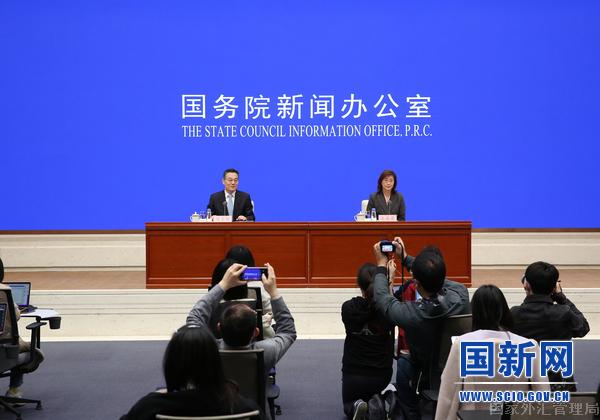
Press conference podium (Photo by Liu Jian)
(The original article is published on www.scio.gov.cn)


